The Pepi I Pyramid Complex, a testament to Ancient Egypt's grandeur, houses the pyramid of Pharaoh Pepi I and nine others for royalty. Discover the Pyramid Texts, insights into the afterlife, and ongoing archaeological revelations
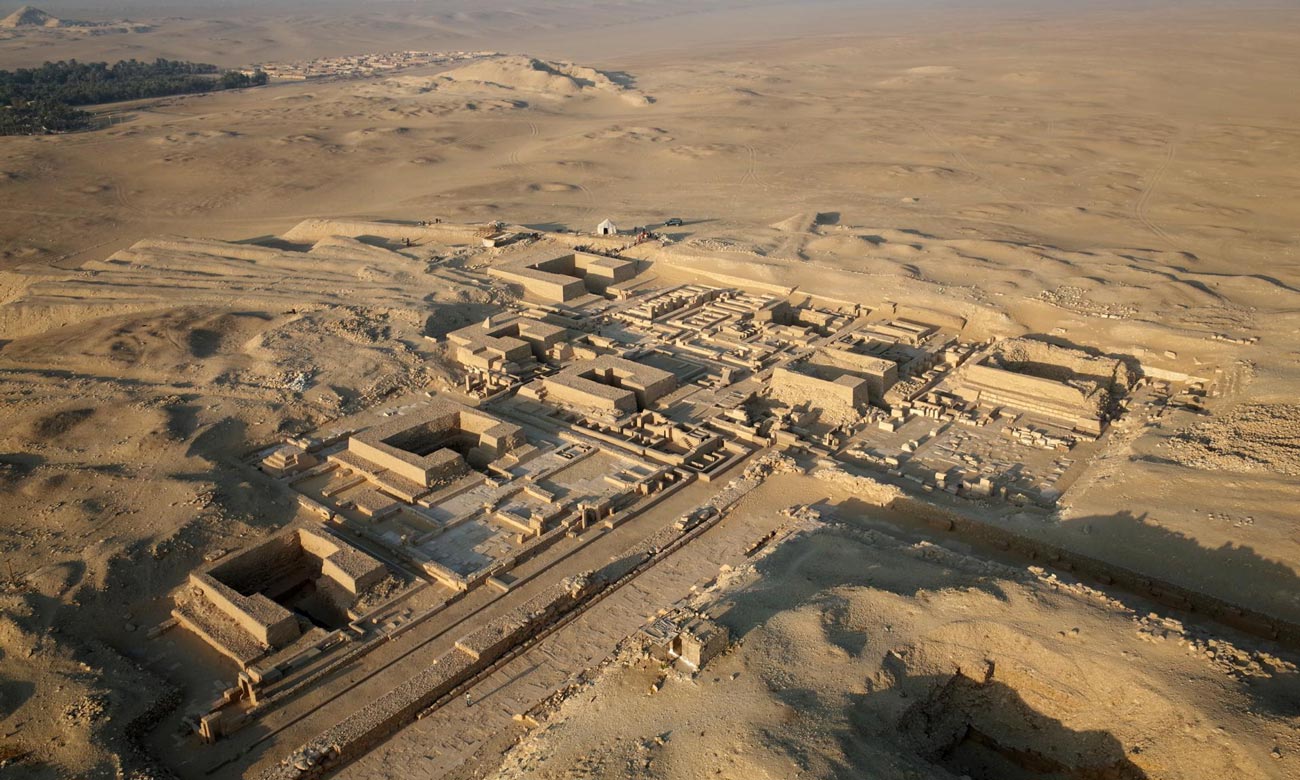
| Overview | |

|
|
| Location | Saqqara, Egypt |
| Pharaoh | Pepi I, 6th Dynasty |
| Construction | Around 2278 BC |
| Material | Limestone Blocks |
| Purpose | Burial Site for Pepi I |
| Design | Hieroglyphic Adornments |
| Exploration | Archaeological Study |
The celestial Pepi I Pyramid Complex is a priceless monument that conveys a plethora of incredible historical and artistic facts on the immortal civilization on Earth. The colossal piece of art is a legendary archaeological wonder that has stood the test of time since the 6th dynasty of the old kingdom in Ancient Egypt (2345 – 2181 BC). The Pepi I Pyramid complex was built by the first king of the 6th dynasty Pepi I, in south Saqqara, which was the subject of a French archaeological mission. All around the main pyramid, about nine pyramids were discovered for the queens and relatives of Pepi I.
His two predecessors, Unas and Teti, chose the vicinity of the step pyramid complex in Saqqara as their final resting place. This monumental attraction represents the last glimpse of the innovations in the art of pyramid construction, where the pharaohs attempted to reach the heavens and enjoy their rightful place against the gods.
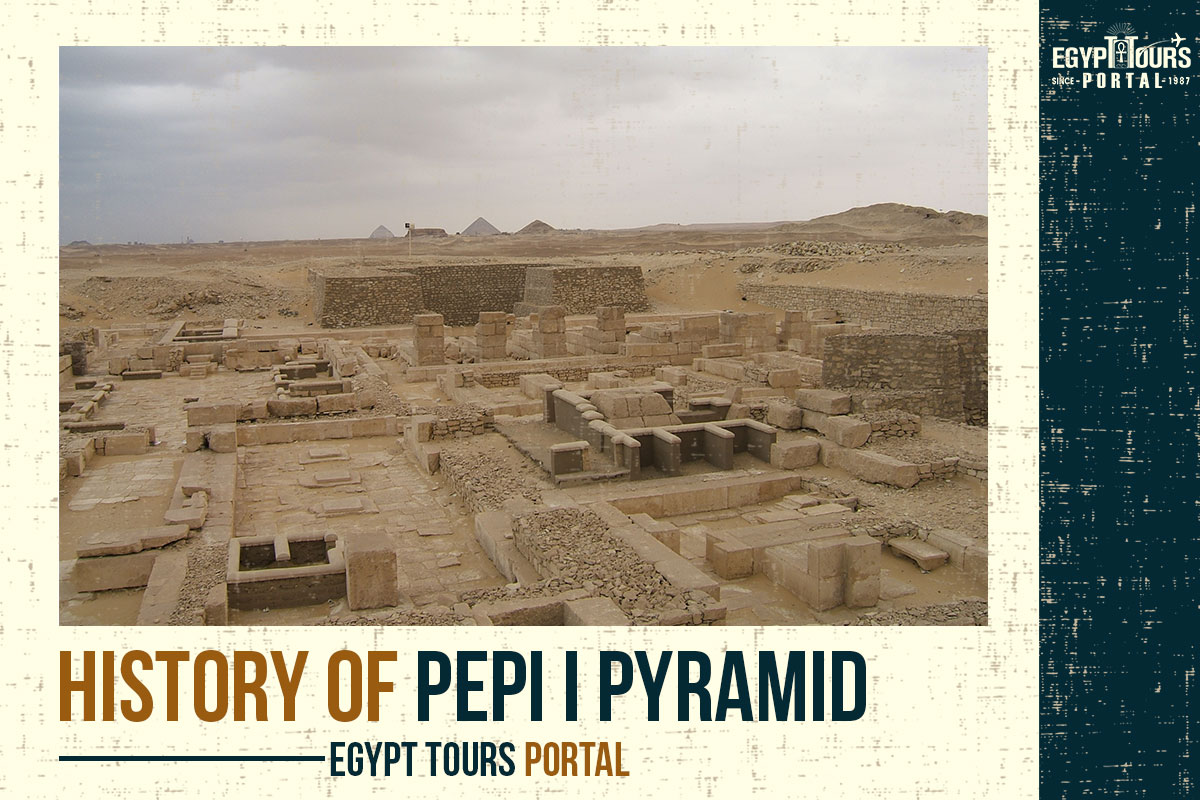
The name of the complex is Mn-Nfr "The Beautiful Monument" which would be the name of the city that resides in the east and would be known by Greeks as Memphis. Pepi I pyramid became highly famous for containing the pyramid texts of the infamous Book of the Dead that acted as a manifesto containing a protection spell and a guiding system for the deceased through the underworld. The Pyramid of Pepi comprises 2,263 columns and text lines which showcase a great deal of information and details about the old kingdom (2686-2181 BC).
The most magnificent findings at this complex are the queens' pyramids, with a total of 9 pyramids uncovered around 2017 within the southwest of Pepi I's complex. The pyramids are associated with queens Inenek-Inti, Nebuunet, Reherishefnakht, Ankhesenpepi II, Meritites IV, Mehaa, Hornetjerikhet, Behenu, and the Western Pyramid. The pyramids of Queens of Behenu and Ankhesenpepi II hold Pyramid Texts, while the pyramid of Reherishefnakht contains both the Coffin Texts and the Pyramid Texts. This discovery holds significance for key reasons as it represents the elder known pyramid not constructed for a royal family member and its epigraphy provides a historical link bridging the Old and Middle Kingdoms.
The pyramid complex of Pepi I is found about 1.5 mi (2.4 km) on the northern side of Djedkare’s pyramid on the Southern side of Saqqara. The construction of the pyramid found in Central and North Saqqara was not possible after pharaoh Teti constructed his pyramid in that location.
This would explain why Pepi I headed to the region of South Saqqara. The crowded and noisy city of Djed-Isut, located on the eastern side of Teti's pyramid, also led Djedkare Isesi and Pepi I to relocate their funerary monuments and royal palaces all the way to the South Saqqara.
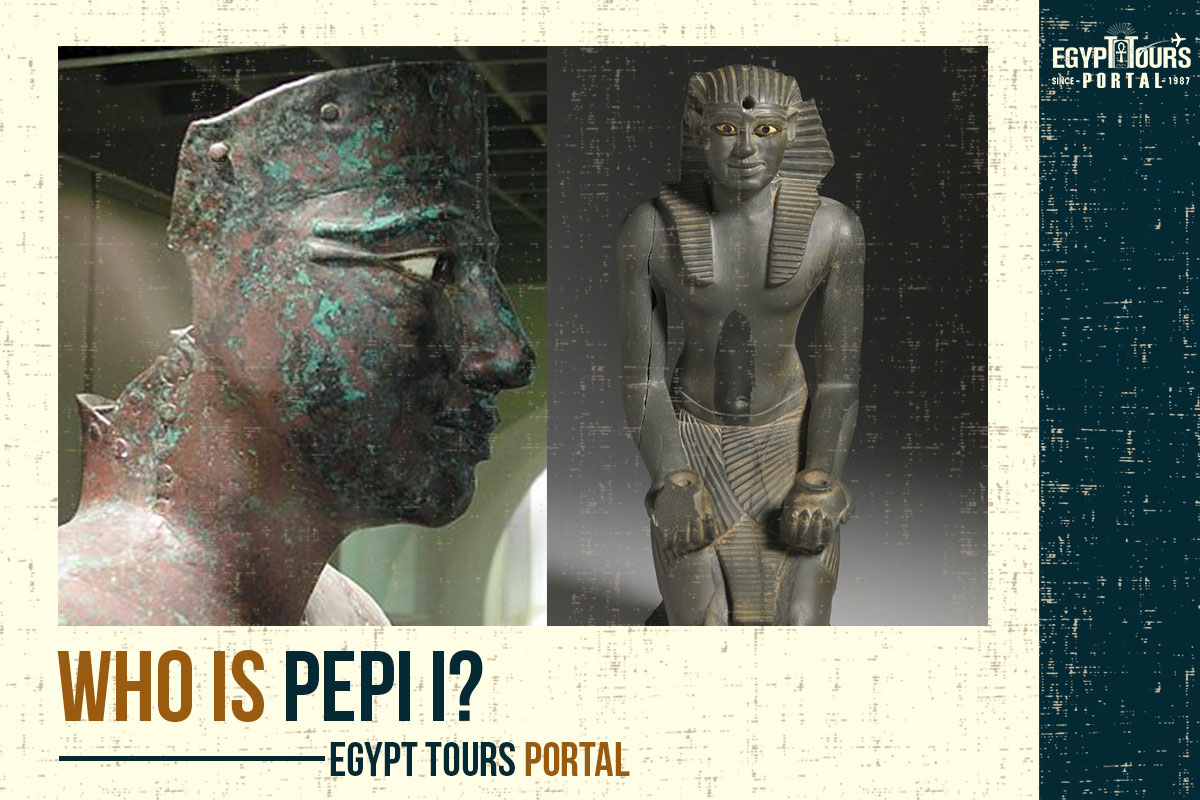
Pepi I Meryre, also known as Pepy I, was one of the prominent pharaohs of ancient Egypt during the Sixth Dynasty, ruling for over 40 years from the 24th to the 23rd centuries BC, which marked the end of the Old Kingdom era. He was the son of Teti, the dynasty's founder, and became king after a brief rule by Userkare. Pepi I had multiple consorts and possibly ruled jointly with his son, Merenre Nemtyemsaf I. His potential son, Pepi II Neferkare, succeeded Merenre as pharaoh.
During his reign, Pepi I faced challenges, including suspicions of his father's murder and conspiracies within his harem and vizier. To maintain his authority in a changing political landscape, he initiated an extensive architectural program, constructing temples and chapels throughout Egypt, especially in the provinces. He also expanded warehouses for tax collection and labor recruitment. In terms of foreign policy, Pepi I conducted military campaigns in Nubia, Sinai, and the southern Levant, fostering trade with regions like Byblos, Ebla, and the Western Desert oases. He also organized mining and quarrying expeditions to Sinai. For his own funerary cult, Pepi I oversaw the construction of a pyramid complex in Saqqara featuring his pyramid and those of his consorts.
The pyramid complex contains the most extensive collection of Pyramid Texts from the Old Kingdom, and these texts also appeared in some of his consorts' pyramids. Pepi's complex was known as Pepi Mennefer and remained significant in his funerary cult into the Middle Kingdom, contributing to the naming of the nearby capital, Memphis. However, his monuments gradually declined during the Second Intermediate Period and faced dismantling during the New Kingdom and the Mamluk era.

The Pepi I pyramid contains all the usual elements of a pyramid complex, such as a mortuary temple and satellite pyramids to the east of the pyramid, plus a causeway that connects to a Valley Temple further east. Despite the complex being damaged by stone thieves, many discoveries were made. In the late '80s a French team of archaeologists examined a massive mound of debris and rubble located to the south of the main pyramid. They were able to find the adjourning mortuary temples of the five Queens of Pepi I.
The queen of which most of the eastern pyramids were built was called Nebwenet, a.k.a, the beloved wife of the king. The queen of the second pyramid is named Inenek-inti; as for the third western pyramid, the identity of the pyramid still remains unknown, but she is known as "The Eldest Daughter Of the King". A stela inscribed with the name "Daughter & Wife Of the King" on a pyramid of Merities IV led to the discovery of the fourth pyramid of Akhesenpepi III and Akhesenpepi II.
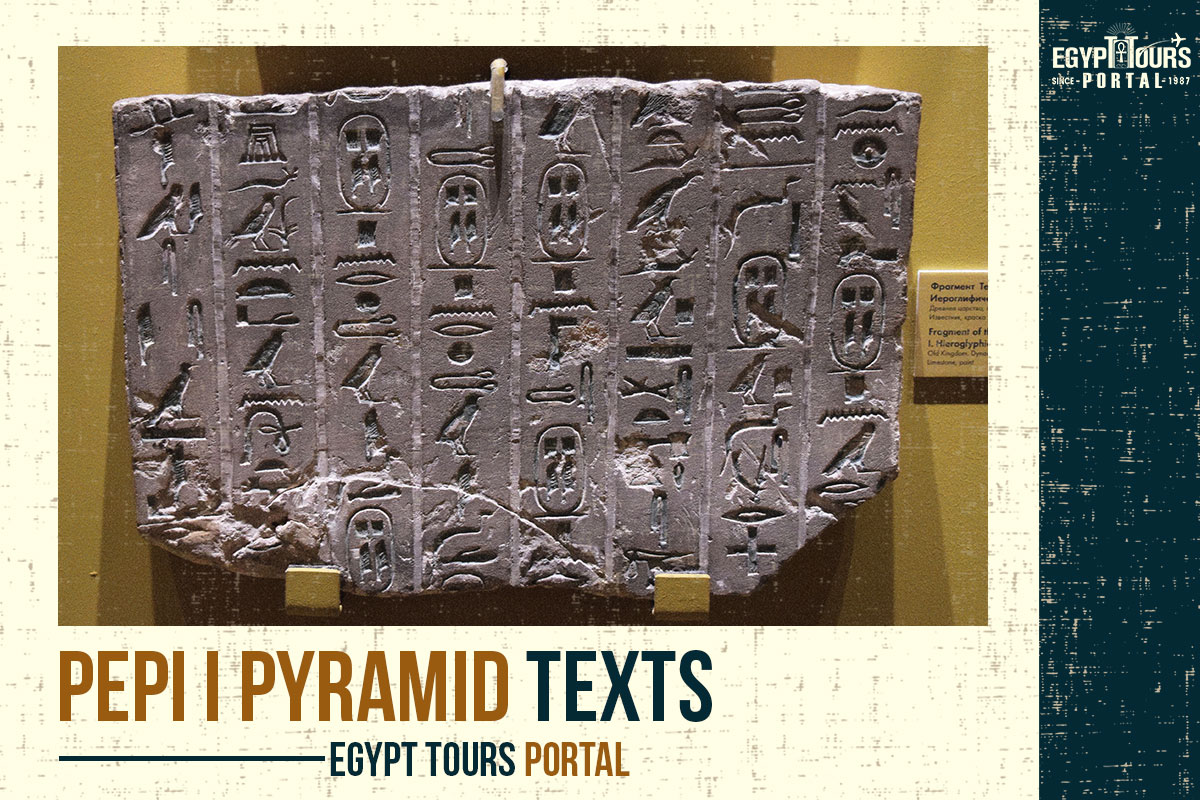
The Pyramid Texts are a collection of ancient Egyptian religious writings that made their initial appearance in the Pyramid of Unas towards the final days of the 5th Dynasty. This tradition endured and continued in the pyramids of all the monarchs from the 6th to 8th Dynasty till the final days of the Old Kingdom. The Pyramid Texts found in the pyramid of Pharaoh Pepi I are made of 2,263 lines and columns of text, thus making it the most extensive collection of such texts that dates all the way to the Old Kingdom. The custom of inscribing these texts began with Pharaoh Unas, who initially unearthed them in the pyramid of Pharaoh Pepi I in 1880.
The Pyramid Texts provide a glimpse into ancient Egyptian beliefs regarding the three fundamental elements of an individual: the physical body, the ba (a unique aspect of the soul), and the ka (a vital life force or spirit). When a person passed away, the ka would detach from the physical body and head back to the ancient Egyptian gods, while the ba is still linked to the body. The physical body placed in the burial chamber would remain in place, but the awakened ba would embark on its journey leading to a new existence, with the Akhet symbolizing the horizon at the time when the sun rises thus playing a pivotal role. The Akhet signified either birth or resurrection, where the king is invoked to be reshaped into an akh, which represents the process of resurrection. Failing to complete this transformation would result in the individual becoming "The Dead" or mutu. The primary purpose of the Pyramid Texts was to facilitate the reunion of the pharaoh's ka and ba, which would lead to the creation of an akh, thus ensuring eternal existence across the ancient Egyptian deities in the celestial realm.
Uncover King Unas'pyramid: Its location, architecture, intricate texts, restoration, and profound contents revealed in ancient incantations.
Read MoreThe burial chamber within Pepi I's pyramid is adorned with Pyramid Texts on all four walls, focusing on themes related to Horus, Osiris, and the king's ascent to the celestial realm. The marvelous north wall is adorned with Insignia and Offering Rituals, which are very special to Pepi I's pyramid and organized into distinct registers. The mesmerizing south wall contains the Resurrection Ritual, centering on the relationship of the king with the ancient Egyptian gods and the departure of the king from this tomb. The east wall explores the connection between the "Ritualist" often the king's son, and his father, Pepi I, as seen across all the personal spells on the walls. The passage connecting the burial chamber and the ante-chamber features four spells which are inscribed on the south and north walls. In the antechamber, the south and west walls address the shift from the human realm to the celestial one, while the north wall holds texts detailing the ruler’s rise to the sky and becoming Horus. The antechamber’s east wall contains spells for the king's protection and provision, and the passage leading to the Serdab is inscribed with the magnificent Morning Ritual. Plus, the Serdab is known to lack any inscriptions.
The texts in the horizontal corridor are divided into three parts, primarily discussing the king's rise to the celestial realm and offering the finest protection of the tomb. The south wall of the vestibule appears to be intended for performance in front of the king’s statue, enabling him to open doors. The east and west walls deal with the king's ability to enter and exit the tomb, while the north wall remains blank. The descending passage of Pepi I and the ascending corridor stand out as they are decorated with Pyramid Texts, although the full content is somewhat obscured due to damage. These texts delve into topics such as the ruler joining the sun god Ra in the celestial realm, the king's cult perpetuation, and provisions for the afterlife.
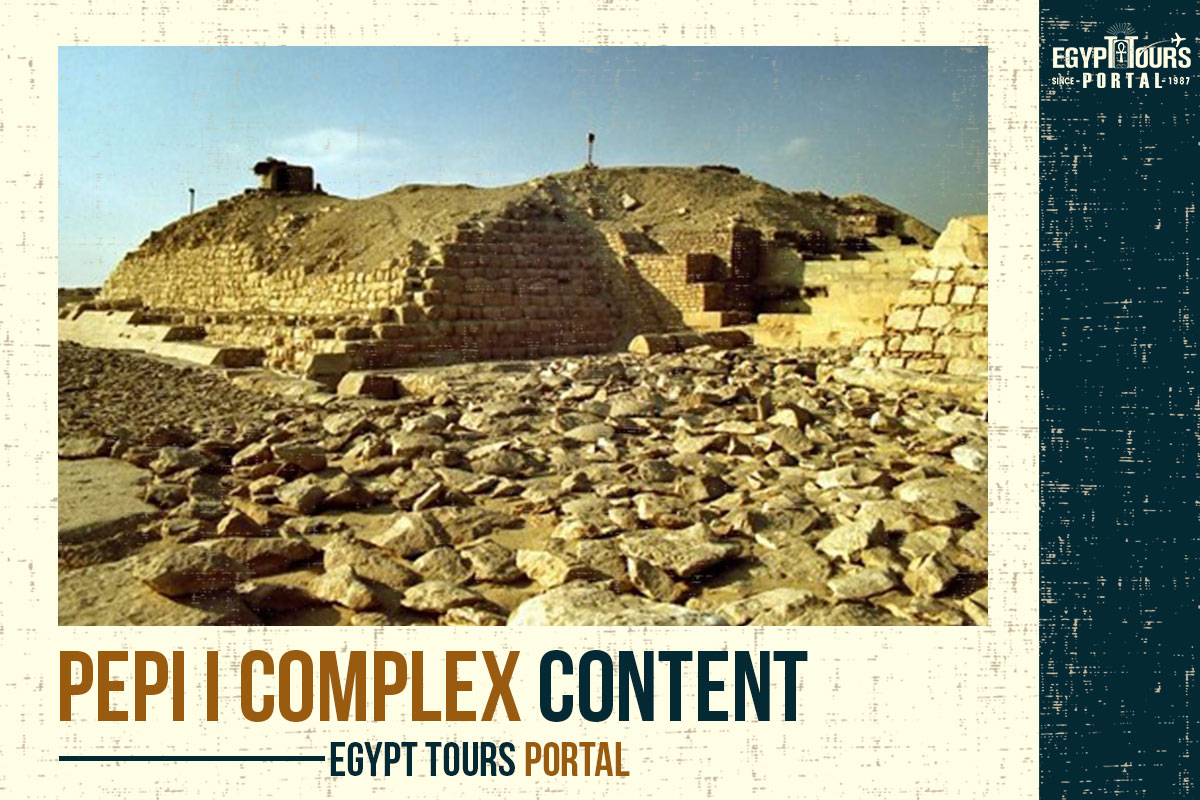
The most significant discoveries at Pepi I's complex are the Queens' pyramids, with a total of nine pyramids found in the southwest area of his pyramid complex. These pyramids belonged to several individuals, including Nebuunet, Meritites IV, Inenek-Inti, Ankhesenpepi III, Reherishefnakht, Mehaa, Behenu, Ankhesenpepi II, and one more individual.
Pepi I's pyramid was built similarly to others, with a core built utilizing small limestone blocks encased in amazing blocks of pure white limestone. The casing of limestone has been mostly removed for lime production, and the pyramid is now destroyed, with its original dimensions estimated. Some inscriptions showcase that the pyramid is connected to Ramses the Great’s son and the high priest of Memphis Khaemwaset. The Pyramid’s base was approximately 78.75 meters long, converging at an angle of ~53 degrees, reaching a peak of 52.5 meters. Today, it remains a 12-meter tall mound that holds a pit in the center.
Nebuunet's pyramid is located to the east of Pepi I's pyramid, which was made during the 5th Dynasty for the burial of Nebuunet, the wife of Pepi I. It is made of limestone and features a descending corridor leading to a burial chamber guarded by a granite portcullis. The pyramid holds a pink granite sarcophagus and remains of funerary equipment like cylindrical wooden weights and wooden ostrich feathers. The complex is entered through a limestone door bearing inscriptions of Nebuunet's name and title.
Inenek-Inti's pyramid is situated adjacent to Pepi I's, is the wife and main vizier of Pepi I, who has a similar design with a descending passage and a granite portcullis. The complex includes a mortuary temple, a greywacke sarcophagus, and two granite pillars with inscriptions of Inenek-Inti's name.
The Western Pyramid belongs to the elder daughter of the ruler featuring a base length of 20 meters. The burial chamber contains ruins of funerary equipment, including copper fish hooks, wooden weights, ostrich feathers, and fired-clay vessels. Relief ruins are scattered throughout the pyramid complex.
Meritites IV's pyramid of the wife of Pepi I is found south of the "Western Pyramid" and has inscriptions of her name and titles in a courtyard with five pillars. The pyramid was restored in 2007 and contains Pyramid Texts. Wooden fragments with Pyramid Texts were discovered during the excavation.
Ankhesenpepi II's pyramid is the second largest in the complex, with a north-south-oriented public mortuary temple and a large burial chamber containing a basalt sarcophagus. An inscription on the basalt sarcophagus identifies her as the mother of the king. There are also inscriptions identifying her as the mother of the king and daughter of Geb and Nut.
Ankhesenpepi III's pyramid is the smallest in the complex and has a burial chamber with a painted sandstone sarcophagus with a granite lid, her titles and name, and inscribed walls. The complex also includes a mudbrick superstructure with a vaulted chamber. There is a burial chamber belonging to Ankhnes, who is the priestess of Hathor, found on the western side of the funerary complex showcasing the pharaoh joining the sun god Ra in the celestial realm, provisions for the afterlife, and the perpetuation of the king's cult.
Mehaa's pyramid is located at the end of "Queen's Street" and has a building dedicated to Prince Hornetjerikhet, the son of Pepi I.
Behenu's pyramid was uncovered in 2007. It is the second-largest Queens' pyramid and features black and red-painted hieroglyphs on the walls. The courtyard has statues of Behenu, and there are various rooms, including a statue chapel and an offering hall.
Reherishefnakht's pyramid was discovered in 2004. It is unique as it does not belong to a member of the royal family dating back to the 11th dynasty. It dates to the end of the Eleventh Dynasty and contains both Pyramid Texts and Coffin Texts, bridging the Old Kingdom and Middle Kingdom of Egypt.
Explore all what you need to know about ancient Egyptian Pyramids, read the most important facts about the builders of Egyptian Pyramids.
Read MoreDuring the Old Kingdom (2700 – 2200 BC), many mortuary complexes were comprised of five crucial components: a valley temple, a causeway, a cult pyramid, a mortuary temple, and the main pyramid.
Pepi I's complex was known as Men-nefer-Pepi, which was adopted as the name of Egypt's first capital city which is known as Memphis. The complex features a main pyramid which is made of 6 limestone steps, a mortuary temple, a cult pyramid, and an unexcavated causeway and valley temple.
Pepi I's pyramid had a marvelous north chapel over the great entrance corridor leading to a grand descending corridor made from pure limestone. The epic corridor featured granite portcullises, and the marvelous layout of chambers within the pyramid was similar to his predecessors. The incredible burial chamber had a painted ceiling with a black background that carried white stars. Although a substitute sarcophagus was located in the chamber, the original may have been damaged during the transportation process or simply had flaws.
Restorative work uncovered a canopic chest made of pink granite which belonged to the king. The chamber also contained mummy fragments, linen wrappings, and other burial equipment. The walls of the chambers were decorated with green hieroglyphic text, with the corridor texts being particularly extensive. The sedan is totally uninscribed, as in other pyramids of the time like the Teti Pyramid and Unas Pyramid.
The mortuary temple associated with Pepi I's complex suffered severe damage from the modern stone thieves of the Fatimid and Mamluk periods who extracted the limestone for the production of lime, which, with time, left behind a great furnace of lime within the grounds of the temple. Nevertheless, the work of the MAFS has led to the reconstruction of the temple's features and plan. The temple followed a standard layout similar to those of earlier pharaohs like Djedkare Unas, Isesi, and Teti. It included an entrance hall that led to an open courtyard with storage magazines on both sides.
The inner temple featured a marvelous chapel with an offering hall, statue niches, and various core chambers. Statues of limestone were found in the inner temple's southwest section, likely placed to protect the tomb or symbolize subjugated people. The original purpose of the limestone statues is still debated among Egyptologists.
The cult pyramid associated with Pepi I's complex is better preserved than the mortuary temple. Many fragments of stelae, statues, and offering tables suggest that the funerary cult remained active and continued all the way to the Middle Kingdom of Egypt. At the time of the New Kingdom of Egypt, the cult pyramid had started to turn completely to ripple.
The cult pyramid had an incredible burial chamber, which was not utilized for any kind of burial, indicating it likely served a symbolic function. The exact purpose behind the cult pyramid is unknown till this current moment. It has housed the ka of the pharaoh, a small statue of the Pharaoh, or possibly been involved in rituals related to the burial and later the resurrection of the pharaoh’s ka when the Sed festival is held.
The wonders of Egypt Egypt are within reach within our vacations to Egypt. The capital Cairo will be in your presence where you will explore monuments and artifacts dating to more than 4000 years like the pyramids of Giza, the Cairo citadel, the hanging church, Khan Eli Khalili Bazaar, countless number mosques, and many more.
You will get to sail on the majestic lifeforce of Egypt the Nile by boarding a mesmerizing Nile river cruise between the marvelous immortal cities of Luxor and Aswan. Also, the natural beauty of the red Rivera in the magical city resort of Hurghada will be within your Grasp. everything you wish for out of a vacation will be waiting for you so don't miss the chance and book us now.
Private 4 Days Cairo Tour Packages for British Travelers 4 days Cairo Egypt Tour pac...
Tour Location: Cairo – Giza...
5 Days Cairo and Alexandria Tour Package For British Travelers 5 days Cairo and Alex...
Tour Location: Cairo/Giza/Alexandria...
6 Days Cairo, Luxor & Aswan Tour Package For British Travelers 6 days Cairo, Lux...
Tour Location: Cairo/Giza/Aswan/Luxor...
Amazing 7 Days Cairo and Hurghada Holiday for British Travelers 7 Days Cairo & H...
Tour Location: Cairo – Giza – Hurgh...
The entire country of Egypt deserve to be explored with its every heavenly detail but there are places that must be seen before any other such as the breathtaking Hurghada's red sea, The wonders of Cairo the pyramids of Giza, the great sphinx, the Egyptian Museum, Khan El Khalili Bazaar, the wonders of Luxor like Valley of the Kings, Karnak & Hatshepsut temple and the wonders of Aswan such as Abu Simbel temples, Philea temple, Unfinished obelisk and The Wonders of Alexandria like Qaitbat Citadel, Pompey's Pillar and Alexandria Library. Read more about the best places to visit in Egypt.
If you want to apply for a Visa On Arrival that lasts for 30 days then you should be one of the eligible countries, have a valid passport with at least 6 months remaining and pay 25$ USD in cash, as for the E-Visa for 30 day you should have a valid passport for at least 8 months, complete the online application, pay the e-visa fee then print the e-visa to later be presented to the airport border guard. You could also be one of the lucky ones who can obtain a free visa for 90 days. Read more about Egypt travel visa.
Egypt has a variety of delicious cuisines but we recommend “Ful & Ta’meya (Fava Beans and Falafel)”, Mulukhiya, “Koshary”, a traditional Egyptian pasta dish, and Kebab & Kofta, the Egyptian traditional meat dish.
The best time to travel to Egypt is during the winter from September to April as the climate becomes a little tropical accompanied by a magical atmosphere of warm weather with a winter breeze. You will be notified in the week of your trip if the Climate is unsafe and if any changes have been made.
You should pack everything you could ever need in a small bag so you could move easily between your destinations.
We have been creating the finest vacations for more than 20 years around the most majestic destinations in Egypt. Our staff consists of the best operators, guides and drivers who dedicate all of their time & effort to make you have the perfect vacation. All of our tours are customized by Travel, Financial & Time consultants to fit your every possible need during your vacation. It doesn't go without saying that your safety and comfort are our main priority and all of our resources will be directed to provide the finest atmosphere until you return home.
You will feel safe in Egypt as the current atmosphere of the country is quite peaceful after the government took powerful measures like restructuring the entire tourist police to include all the important and tourist attractions in Egypt. Read more about is it safe to travel to Egypt.
Wear whatever feels right and comfortable. It is advised to wear something light and comfortable footwear like a closed-toe shoe to sustain the terrain of Egypt. Put on sun block during your time in Egypt in the summer to protect yourself from the sun.
The best activity is by far boarding a Nile Cruise between Luxor and Aswan or Vise Versa. Witness the beauty of Egypt from a hot balloon or a plane and try all the delicious Egyptian cuisines and drinks plus shopping in old Cairo. Explore the allure and wonders of the red sea in the magical city resorts of Egypt like Hurghada and many more by diving and snorkeling in the marine life or Hurghada. Behold the mesmerizing western desert by a safari trip under the heavenly Egyptian skies.
There are a lot of public holidays in Egypt too many to count either religious or nation, the most important festivals are the holy month of Ramadan which ends with Eid Al Fitr, Christmas and new years eve. Read more about festivals & publich holidays in Egypt.
Egypt is considered to be one of the most liberal Islamic countries but it has become a little bit conservative in the last couple of decades so it is advised to avoid showing your chest, shoulders or legs below the knees.
Arabic is the official language and Most Egyptians, who live in the cities, speak or understand English or at least some English words or phrases. Fewer Egyptians can speak French, Italian, Spanish, and German. Professional tour guides, who work in the tourism sector, are equipped to handle visitors who cannot speak Arabic and they will speak enough English and other languages to fulfill the needs of all our clients.
The fastest way is a car, of course, a taxi. If you are in Cairo ride a white taxi to move faster or you could board the fastest way of transportation in Egypt metro if the roads are in rush hour.
The temperature in Egypt ranges from 37c to 14 c. Summer in Egypt is somehow hot but sometimes it becomes cold at night and winter is cool and mild. The average of low temperatures vary from 9.5 °C in the wintertime to 23 °C in the summertime and the average high temperatures vary from 17 °C in the wintertime to 32 °C in the summertime. The temperature is moderate all along the coasts.
It is the home of everything a traveler might be looking for from amazing historical sites dating to more than 4000 years to enchanting city resorts & beaches. You will live the vacation you deserve as Egypt has everything you could possibly imagine.









